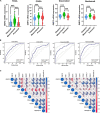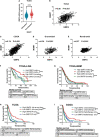Expression and Prognostic Role of Glia Maturation Factor-γ in Gliomas
- PMID: 35845613
- PMCID: PMC9277395
- DOI: 10.3389/fnmol.2022.906762
Expression and Prognostic Role of Glia Maturation Factor-γ in Gliomas
Abstract
Background: Glia maturation factor-γ (GMFG) regulates actin cytoskeletal organization and promotes the invasion of cancer cells. However, its expression pattern and molecular function in gliomas have not been clearly defined.
Methods: In this study, public datasets comprising 2,518 gliomas samples were used to explore GMFG expression and its correlation with malignancy in gliomas. Immunohistochemistry (IHC) staining was performed to determine the expression of GMFG in gliomas using an in-house cohort that contained 120 gliomas samples. Gene ontology enrichment analysis was conducted using the DAVID tool. The correlation between GMFG expression and immune cell infiltration was evaluated using TIMER, Tumor Immune Single-Cell Hub (TISCH) database, and IHC staining assays. The Kaplan-Meier analysis was performed to determine the prognostic role of GMFG and its association with temozolomide (TMZ) response in gliomas.
Results: The GMFG expression was higher in gliomas compared with non-tumor brain tissues both in public datasets and in-house cohort. High expression of GMFG was significantly associated with WHO grade IV, IDH 1/2 wild-type, and mesenchymal (ME) subtypes. Bioinformatic prediction and IHC analysis revealed that GMFG expression obviously correlated with the macrophage marker CD163 in gliomas. Moreover, both lower grade glioma (LGG) and glioblastoma multiforme (GBM) patients with high GMFG expression had shorter overall survival than those with low GMFG expression. These results indicate that GMFG may be a therapeutic target for the treatment of such patients. Patients with low GMFG expression who received chemotherapy had a longer survival time than those with high GMFG expression. For patients who received ion radiotherapy (IR) only, the GMFG expression level had no effect on the overall survival neither in CGGA and TCGA datasets.
Conclusion: The GMFG is a novel prognostic biomarker for patients with both LGG and GBM. Increased GMFG expression is associated with tumor-associated macrophages (TAMs) infiltration and with a bad response to TMZ treatment.
Keywords: GMFG; gliomas; immune; prognosis; temozolomide.
Copyright © 2022 Liu, Zhu, Gao, Geng, Tao, Xu and Chen.
Conflict of interest statement
The authors declare that the research was conducted in the absence of any commercial or financial relationships that could be construed as a potential conflict of interest.
Figures








Similar articles
-
Integrated bioinformatics analysis and experimental validation on malignant progression and immune cell infiltration of LTBP2 in gliomas.BMC Cancer. 2024 Oct 10;24(1):1252. doi: 10.1186/s12885-024-12976-2. BMC Cancer. 2024. PMID: 39390437 Free PMC article.
-
Bioinformatics and survival analysis of glia maturation factor-γ in pan-cancers.BMC Cancer. 2021 Apr 17;21(1):423. doi: 10.1186/s12885-021-08163-2. BMC Cancer. 2021. PMID: 33863293 Free PMC article.
-
CHI3L2 Is a Novel Prognostic Biomarker and Correlated With Immune Infiltrates in Gliomas.Front Oncol. 2021 Apr 15;11:611038. doi: 10.3389/fonc.2021.611038. eCollection 2021. Front Oncol. 2021. PMID: 33937022 Free PMC article.
-
Gasdermin D Is a Novel Prognostic Biomarker and Relates to TMZ Response in Glioblastoma.Cancers (Basel). 2021 Nov 10;13(22):5620. doi: 10.3390/cancers13225620. Cancers (Basel). 2021. PMID: 34830775 Free PMC article.
-
MCM10 as a novel prognostic biomarker and its relevance to immune infiltration in gliomas.Technol Health Care. 2023;31(4):1301-1317. doi: 10.3233/THC-220576. Technol Health Care. 2023. PMID: 36872806
Cited by
-
Integrated bioinformatics analysis and experimental validation on malignant progression and immune cell infiltration of LTBP2 in gliomas.BMC Cancer. 2024 Oct 10;24(1):1252. doi: 10.1186/s12885-024-12976-2. BMC Cancer. 2024. PMID: 39390437 Free PMC article.
-
LncRNA NDUFA6-DT: A Comprehensive Analysis of a Potential LncRNA Biomarker and Its Regulatory Mechanisms in Gliomas.Genes (Basel). 2024 Apr 11;15(4):483. doi: 10.3390/genes15040483. Genes (Basel). 2024. PMID: 38674418 Free PMC article.
-
[High expression of UBE2S promotes progression of hepatocellular carcinoma by increasing cancer cell stemness].Nan Fang Yi Ke Da Xue Xue Bao. 2024 Mar 20;44(3):455-464. doi: 10.12122/j.issn.1673-4254.2024.03.06. Nan Fang Yi Ke Da Xue Xue Bao. 2024. PMID: 38597436 Free PMC article. Chinese.
-
Identification of GMFG as a novel biomarker in IgA nephropathy based on comprehensive bioinformatics analysis.Heliyon. 2024 Apr 2;10(7):e28997. doi: 10.1016/j.heliyon.2024.e28997. eCollection 2024 Apr 15. Heliyon. 2024. PMID: 38601619 Free PMC article.
-
BCL2A1 is associated with tumor-associated macrophages and unfavorable prognosis in human gliomas.Aging (Albany NY). 2023 Oct 25;15(20):11611-11638. doi: 10.18632/aging.205149. Epub 2023 Oct 25. Aging (Albany NY). 2023. PMID: 37889551 Free PMC article.
References
LinkOut - more resources
Full Text Sources
Research Materials

